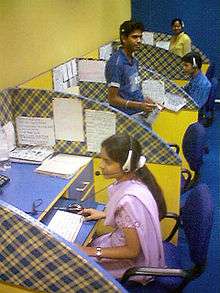Call center industry in India
The call center industry in India is a part of India's business process outsourcing industry.

Centers
A call center is an office with the capacity to field many telephone calls for a company.[1] Types of call center work can include customer service and telemarketing. Factors that have made India attractive as a hub of call center work from the US, UK, and Australia include its convenient time zone, low labor costs, and large English-speaking population.[2][3] The introduction of call center and other business processing work to India picked up in the 1990s as Fortune 500 countries began offshore outsourcing this work to India.[3] British Airways, American Express, and Dell are examples of companies that utilize call centers in India.[4][3] Other countries with comparable call center industries include Bangladesh and the Philippines.
Workers
There were approximately 350,000 call center workers in India as of February 2015.[5] Call center workers in India are largely under the age of thirty, unmarried, and college-educated, regardless of gender.[6] Call center work is typically done overnight to accommodate time zones in the US, UK, and Australia, and employees are required to be fluent in English.[3]
Gendered dynamics
Although there are roughly equal numbers of men and women working in the lower levels of the call center industry, scholars analyze gendered dynamics of call center work because of the association of call center work tasks with femininity and feminine traits such as hospitality and empathy.[4][3] There are also fewer job opportunities for women (see also: gender inequality in India) and the wages of call center jobs are higher relative to other jobs that are open to women.[7] Women in call center work are more likely to consider their jobs as permanent, or as their permanent employment until they marry, whereas men typically view their call center jobs as temporary.[7]
There have been many scholars that have studied the gendered impacts of call center work on Indian women. Some of these researchers have claimed that there are ways in which call center work subverts gendered expectations of Indian womanhood, and can thus be in some ways liberating.[6][4][3] Many of these scholars point to the opportunity for financial gain or independence.[6][3] They have also taken into consideration the workplaces themselves as environments where gender norms are subverted, though these environments are still hierarchical with men still more commonly holding leadership positions.[6][4]
Singh and Pandey in their research on the impact of call center work on the health of female call center workers in India found that many young women suffered from ailments such as indigestion, eye strain, headache, and sleep disorder due to the abnormal hours call center work entails.[2] To adjust to the hours, many workers turned to and subsequently became addicted to caffeine and cigarettes.[8][2]
Various researchers describe the stigma that Indian women experience when they work at night as call center work requires.[6][3] Being outside of the house at night is not considered respectable for single young Indian women, and thus challenges gendered expectations.[3][9] Because of this the reputations of young women working in call centers are called into question, which in turn can prevent their families from making any gain in status from their employment.[10][6]
Media portrayals
Indian call centres have been the focus of several documentary films, the 2004 film Thomas L. Friedman Reporting: The Other Side of Outsourcing, the 2005 films John and Jane, Nalini by Day, Nancy by Night, and 1-800-India: Importing a White-Collar Economy, and the 2006 film Bombay Calling, among others.[11] An Indian call centre is also the subject of the 2006 film Outsourced and a key location in the 2008 film, Slumdog Millionaire.
Chetan Bhagat's bestselling book One Night @ the Call Center is based on call centre employees.
References
- "Definition of CALL CENTER". www.merriam-webster.com. Retrieved 2018-12-03.
- Singh, Preeti; Pandey, Anu (2005). "Women in Call Centres". Economic and Political Weekly. 40 (7): 684–688. JSTOR 4416207.
- Patel, Reena (2010). Working the Night Shift: Women in India's Call Center Industry. Stanford CA: Stanford University Press. pp. 2. ISBN 978-0-8047-6913-6.
- Mirchandani, Kiran (2005). "Gender Eclipsed? Racial Hierarchies in Transnational Call Center Work". Social Justice. 32 no 4(102) (4 (102)): 105–119. JSTOR 29768339.
- White, King. "How Big is the U.S. Call Center Industry Compared to India and The Philippines?". Retrieved 2018-12-03.
- Mattingly, Doreen (2012). "Indian Women Working in Call Centers: Sites of Resistance?". In Pande, Rekha; van der Weide, Theo (eds.). Globalization, Technology Diffusion and Gender Disparity: Social Impacts of ICTs. IGI Global. pp. 156–168. ISBN 9781466600201.
- McMillin, Divya (2006). "Outsourcing Identities: Call Centres and Cultural Transformation in India". Economic and Political Weekly. 41 (3): 235–241. JSTOR 4417702.
- D'Cruz, Premilla; Noronha, Ernesto (2013). "Hope to Despair: The Experience of Organizing Indian Call Centre Employees". Indian Journal of Industrial Relations. 48 (3): 471–486. JSTOR 23510793.
- Mishra, Swati (June 2017). "Recasting Respectability: Imagination, Desire and Modernity among Call-Center Workers in India". Asian Journal of Women's Studies. 23 (2): 203–223. doi:10.1080/12259276.2017.1317704 – via EBSCOhost.
- Parikh, Aparna (May 2018). "Politics of Presence: Women's Safety and Respectability at Night in Mumbai, India". Gender, Place & Culture: A Journal of Feminist Geography. 25 (5): 695–710. doi:10.1080/0966369X.2017.1400951 – via EBSCOhost.
- Hudson, Dale (2009). "Undesirable Bodies and Desirable Labor: Documenting the Globalization and Digitization of Transnational American Dreams in Indian Call Centers". Cinema Journal. 49 (1): 82–102. doi:10.1353/cj.0.0164.